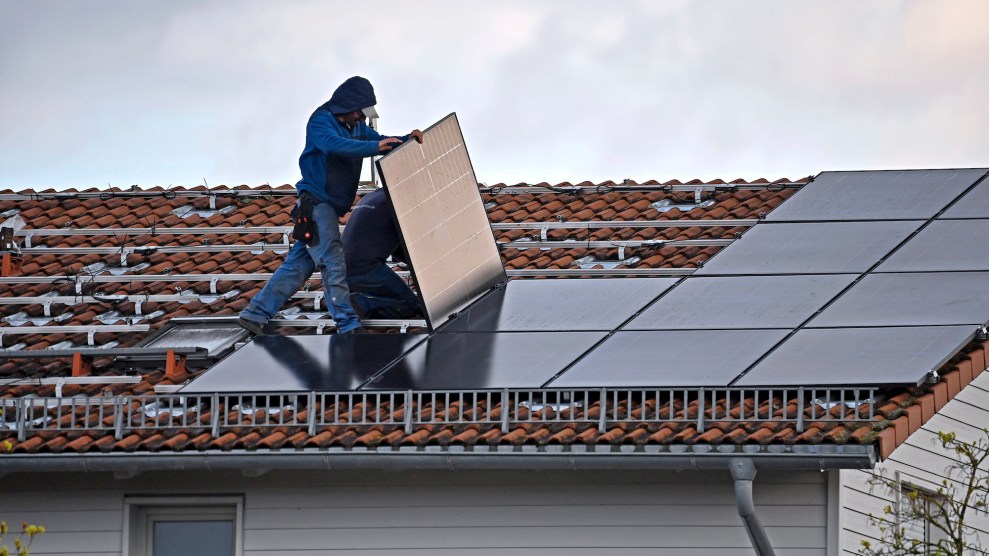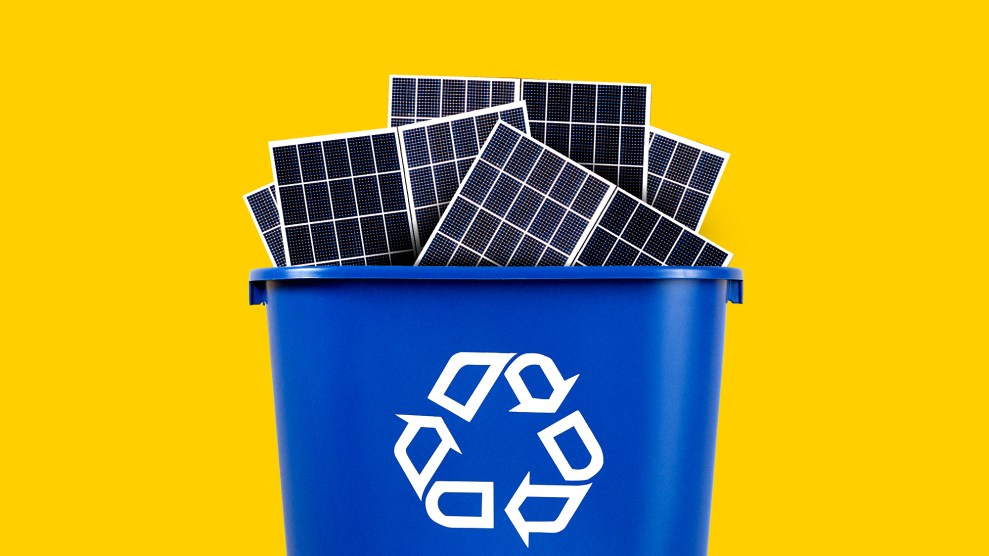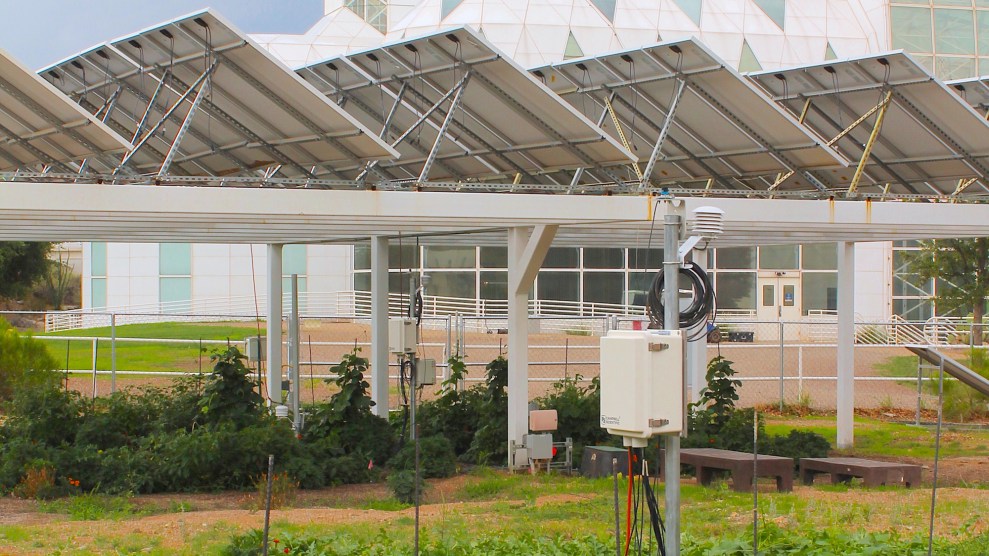
Today’s solar panels use silicon-based cells but are rapidly approaching their maximum conversion of sunlight to electricity of 29%.Frank Hoermann/Sven Simon/Zuma
This story was originally published by the Guardian and is reproduced here as part of the Climate Desk collaboration.
Solar power cells have raced past the key milestone of 30 percent energy efficiency, after innovations by multiple research groups around the world. The feat makes this a “revolutionary” year, according to one expert, and could accelerate the rollout of solar power.
Today’s solar panels use silicon-based cells but are rapidly approaching their maximum conversion of sunlight to electricity of 29 percent. At the same time, the installation rate of solar power needs to increase tenfold in order to tackle the climate crisis, according to scientists.
The breakthrough is adding a layer of perovskite, another semiconductor, on top of the silicon layer. This captures blue light from the visible spectrum, while the silicon captures red light, boosting the total light captured overall. With more energy absorbed per cell, the cost of solar electricity is even cheaper, and deployment can proceed faster to help keep global heating under control.
The perovskite-silicon “tandem” cells have been under research for about a decade, but recent technical improvements have now pushed them past the 30 percent milestone. Experts said that if the scaling-up of production of the tandem cells proceeds smoothly, they could be commercially available within five years, about the same time silicon-only cells reach their maximum efficiency.
Two groups published the details of their efficiency breakthroughs in the journal Science on Thursday, and at least two others are known to have pushed well beyond 30 percent. “This year is a revolutionary year,” said Prof. Stefaan De Wolf, at King Abdullah University of Science and Technology in Saudi Arabia. “It’s very exciting that things are moving rapidly with multiple groups.”
The current efficiency record for silicon-only solar cells is 24.5 percent in commercial cells and 27 percent in the laboratory. The latter may well be as close the cells can practically get to the theoretical maximum of 29 percent.
But one group, led by Steve Albrecht at the Helmholtz Center Berlin for Materials and Energy in Germany, has now published information about how they achieved efficiencies of up to 32.5 percent for silicon-perovskite cells. The other group, led by Dr. Xin Yu Chin at the Federal Institute of Technology in Lausanne, Switzerland, demonstrated an efficiency of 31.25 percent and said tandem cells had the “potential for both high efficiency and low manufacturing costs.”
“What these two groups have shown are really milestones,” said De Wolf. His own group achieved 33.7 percent efficiency with a tandem cell in June, but has yet to publish the results in a journal. All the efficiency measurements were independently verified.
“Overcoming the 30 percent threshold provides confidence that high-performance, low-cost PVs can be brought to the market,” said De Wolf. Global solar power capacity reached 1.2 terawatts in 2022. “Yet to avert the catastrophic scenarios associated with global warming, the total capacity needs to increase to about 75 TW by 2050,” he said.
The solar industry is also part of the race to high efficiency. Chinese company LONGi, the world’s biggest producer of solar cells, announced in June they had reached 33.5 percent in their research. “Reducing the cost of electricity remains the perpetual theme driving the development of the photovoltaic industry,” said Li Zhenguo, the president of LONGi.
“The industry is running very, very fast,” De Wolf said. “And I’m sure that multiple companies are working on this in China.” Europe and the US need to increase its research and development funding to keep up and contribute to an accelerating rollout of solar power, he said.
All of the high-efficiency tandem cells above 30 percent efficiency are small so far, measuring 1 cm by 1 cm. They now need to be scaled up to the size of commercial cells, which are 15 cm squares.
The scale-up is already under way with UK company Oxford PV announcing in May a record 28.6 percent efficiency for a commercial-size cell. “Solar is already one of the least expensive and cleanest forms of energy available, and our technology will make it even more affordable,” said Chris Case, chief technology officer at Oxford PV.
The Oxford PV cell was made on the same production line as conventional silicon-only cells, making the large-scale production of tandem cells far easier. Tandem cells may prove to be more expensive than silicon-only cells, but the cells are only a small part of the cost of producing and installing solar panels, De Wolf said.
One issue that remains to be resolved is how fast the tandem cells degrade over time in real-world conditions. Today’s solar cells still have 80-90 percent of their capacity after 25 years and De Wolf said tandems would have to match that, but that there was only limited data on their stability to date.
The key to the higher efficiencies of the tandem cells from the German and Swiss groups was tackling tiny defects on the surface of the perovskite layer. These allow some electrons liberated by solar photons to flow back into the perovskite, rather than contributing to the cell’s electrical current and therefore reducing its efficiency.
The solution was to put a layer of organic molecules between the perovskite and the conducting layer through which the current flows, which compensated for the defects.
Significantly, all the groups used different methods to address the problem, giving more options in the search for the best commercial design, said De Wolf. “There’s still lots of room to go further,” he said. “I believe that the practical limit is well beyond 35 percent.”
Prof Rob Gross, director of the UK Energy Research Centre, said: “Solar is already a low-cost way to generate electricity and has a wide resource base across the world. The cost reductions already achieved are the main reason solar now plays such a large role in scenarios of decarbonized energy systems. Improvements in efficiency have the potential to increase the output of solar and therefore will help to reinforce that effect.”
There are other technologies, such as multi-junction cells, which can have efficiencies as high as 47 percent but these are very expensive to produce and would only be suitable for niche uses such as on space satellites or when sunlight is highly concentrated on to the cells.













